Are you trekking out into the backcountry? If so, don’t forget to bring your best camping radio. You may be in a location where Bluetooth and Wi-Fi are not available. It’s always better to be prepared for a finished meal halfway through. The features of the best portable radio are undoubtedly useful.
Camper radios are a completely different breed. Because this outdoor camping equipment is usually more than just a radio. You can use it in survival situations. The best radio for camping even has special abilities that allow the owner to get out of difficult situations.
In a 12v camping setup, you’re not just buying the radio itself, you’re buying all the parts. If you’re just looking for a simple radio, you should go for the regular transistor version. A radio for camping is more than just a radio.
| Picture | Name of product | Features |
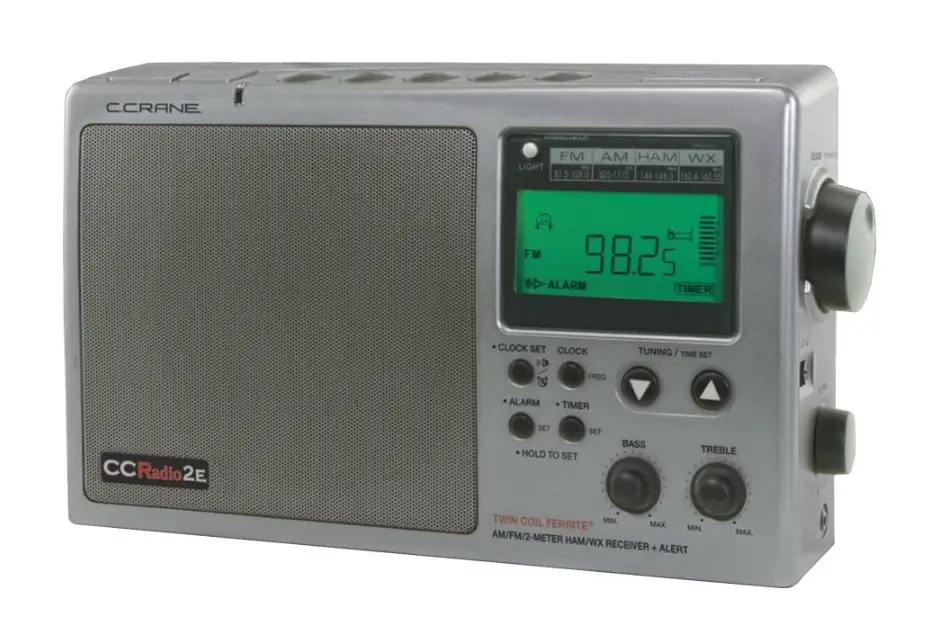 | C. Crane CC Radio-2E Enhanced Portable | 5 customizable One Touch memory presets for each band, adjustable display, backlight, alarm clock, sleep timer, auto scan, headphone jack, stereo out jack, bass and treble and line out jack. Runs an AC power cord or four (optional) D-cell batteries included with a long-life battery. Weight: 4 lbs. (Without batteries) Size: 11″W x 6.5″H x 4″ D. |
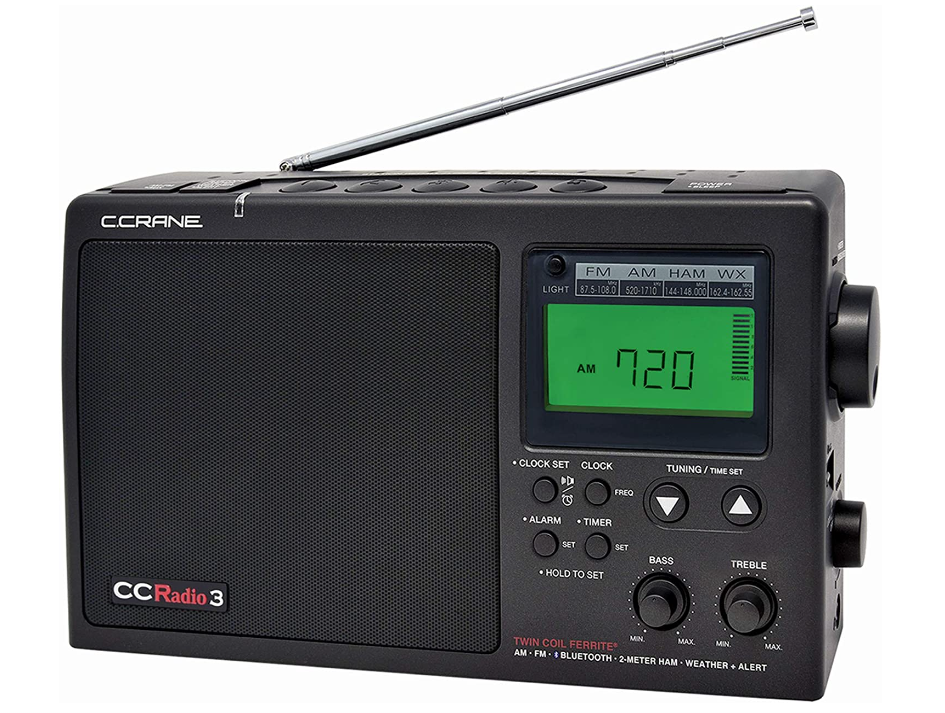 | C. Crane CCRadio 3 | Clock, alarm, sleep timer, headphone jack, adjustable display light, and 5 one-touch memory presets per band. Comes with an AC power cord, and runs on 4 “D” size batteries (not included). Extra Long Battery Life of approximately 250 hours while playing at a moderate volume. Comes with 1 Year Limited Warranty and C. Crane US-based tech support. |
 | Eton – Elite 750 portable radio | The STANDARD OF EXCELLENCE: The Elite Series delivers the best performance in radio reception and audio quality. The Etón Elite 750 has the classic looks and the style to match. ON EVERY WAVELENGTH: The Etón Elite 750 broadcasts every radio wavelength-AM, FM, LW, SW, SBB, and VHF aircraft band frequencies |
 | Eton – Elite Executive | The Elite Executive receives every radio wavelength—AM(MW), FM with RDS, LW, and Shortwave (SW)—at home or abroad. Plus, it also receives VHF aircraft band, Single Sideband (SSB), and includes a PLL tuner so your AM signal is strong and clear. It features a leather case with craftsman stitching for ultimate portability. Power Supply: Charging cable with AC adapter or 4 AA batteries (sold separately) 4.1″ x 6.6″ x 1.2″ (H x W x D) |
 | Eton Sidekick Weather Alert Emergency Radio | Solar Powered, Battery Powered, Bluetooth, Rechargeable, LED Flashlight, Phone Charger. |
 | Midland ER300 Emergency Radio | AM/FM NOAA Emergency Crank Radio with Solar Power Panel Extremely Bright Cree LED Flashlight 130 Lumens Ultrasonic Dog Whistle to assist search and rescue teams Replaceable 2000 mAh Rechargeable Lithium Ion Battery with USB Output for charging Portable Devices SOS Flashlight beacon that flashes Morse code |
 | Kaito Emergency Radio Voyager Max KA900 | Headset jack socket: 3.5 mm Sensitivity: FM<10uV MW<1mV/m SW < 30uV Rechargeable battery: 2,000 mAh Li-ion Dimensions:9 ½ x 5 ½ x 2 ½ inches Weight: 1 lb 11 oz |
7 Best camping radio reviews
1. C. Crane CC Radio-2E Enhanced Portable
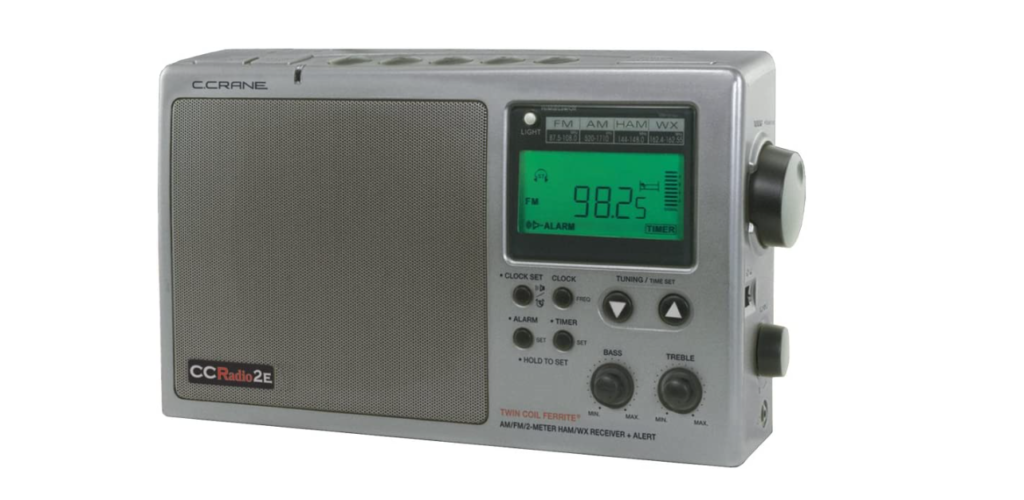
The portable AM and FM radios are designed for long-distance reception and excellent sound quality and for emergencies. Good reception and great sound are the two most important and important reasons for choosing portable radios.
For over 10 years, C. Crane’s CCRadio line has featured the best AM reception available on the emergency radio. In the greatly improved new version of CC radio-2, the sound can be adjusted even more precisely for a more realistic perception of the human voice.
On the other hand, it can be adapted for great musical use. FM stations reception is sure to please you too. Five-button memory on top of the radios makes switching easier instead of the buttons on the front.
AM performance improvements are achieved with C. Crane’s patented single-coil ferrite AM antenna. This technology can greatly boost weak AM signals in most cases. After selecting a station, CCradio-2E evaluates the signal for a few seconds and then fixes the signal at the highest possible level.
The display is fully backlit, has three levels of brightness, and is set to OFF. The time range can keep you updated on any Noaa weather alerts. The two-meter amateur portable radio band can make the CCradio-2E a lifesaver in an emergency.
2.C. Crane CCRadio 3

CC Radio has excellent sound quality, bass and treble controls, and excellent reception. On a recent hike, the weather radio warned us of an approaching thunderstorm. It’s nice to have high-quality radio again.
In addition to AM and FM, the Bluetooth-enabled CCRadio 3 can receive a huge amount of new portable radio broadcasts available from any Bluetooth-enabled smart speaker (such as newer voice service devices, Google Home devices, etc.) and smartphones. Your smart speaker app on your phone can act as a remote control for your smart speaker while you listen via Bluetooth.
CCRadio 3 provides exceptional long-range AM/FM radio reception as well as an emergency response capability. Great for listening to local stations. Accurate voice reproduction portable radio delivers transparent sound.
The sound quality of the spoken word is so good that it feels like the person is right next to you. When you listen to your favorite radio show, podcast, or audiobook, you become part of it. Separate bass and treble controls can be adjusted to the perfect tone.
It also sounds great in music, plus you can hear the lyrics more easily. If you listen to mostly voice content, the sound of the CCRadio 3 might be worth the price. Notes: Bluetooth sometimes creates noise on AM and FM due to digital circuits.
The CCRadio 3 is one of the few high-performance Bluetooth radios that have no detectable noise and has some of the best reception available. The full backlit LED display has three levels of brightness, including an off setting. Weather radio has a technical support service in the USA.

FM reception is just as good as the best portable radio. Excellent FM sensitivity and selectivity allow these portable radios to pick up some problematic signals clearly, and they are among the best portable FM radios I have ever tested. I mentioned earlier that my location near the top of a hill in Connecticut allows unusual FM reception from Maine to Cape Cod, Massachusetts, and New York.
Some frequencies have multiple stations that can be separated by reorienting the rod antenna or moving the weather radio a foot or two back and forth. (I have since moved to Kentucky, but am again at a fairly high altitude and the FM band is full of densely packed signals).
Some signals are weak and most of them are overflowing on a very full dial. The CC-3 and CC-2E share as many stations as any other portable FM radio I own, and better than most.
Top-mounted buttons are not completely resistant to dirt or dust penetration. When used in such conditions, care must be taken to keep the top of the weather radio clean, as dirt can cause switching problems.
Overload in areas with a strong signal. The CC-3 and CC-2E are extremely sensitive radios and in most places can pick up stations that sound much weaker or even absent from less sensitive radios.
However, they are not as good as some of the very best vintage radios in terms of resisting overload in the presence of a lot of heavy-duty signals. Luckily, this doesn’t happen in most places – obviously, factors like frequency and possibly a combination of multiple mega signals are needed to cause the problem to occur.
3. Eton – Elite 750 portable radio
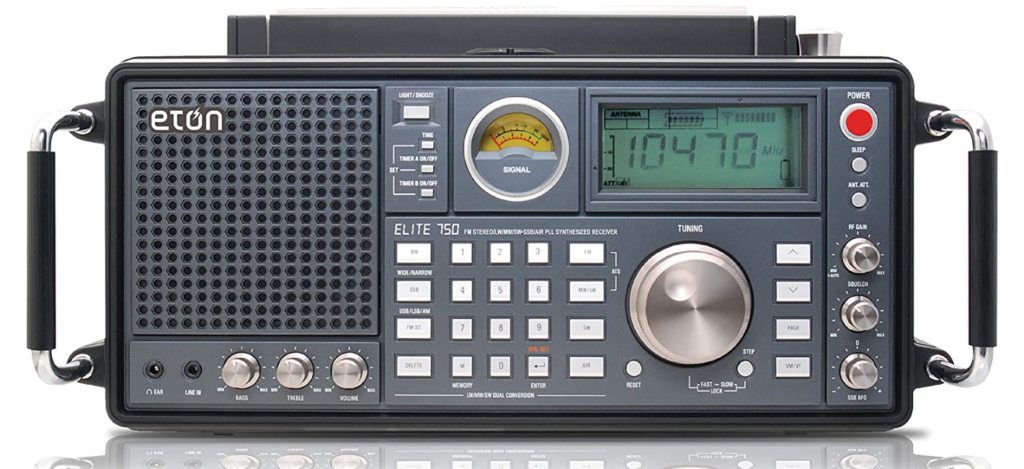
Elite 750 has a wealth of experience in quality assurance from Eton.
Excellent portable radio reception and sound quality. It has classic looks and styles to match its outstanding features. If you want a radio that can be heard anywhere, the Elite 750 is the best portable radio for you that broadcasts on all wavelengths – AM, FM, LW, SW, SSB, and VHF on air frequencies.
These are some of the best desktop radios out there. Meet the Eton FRX3, an AM/FM/Noaa weather handheld turbine radio with a USB port and LED light. At $60, that’s not an issue as it could pay dividends in a pinch. A small backlit display shows the FM stations and the time.
A very good SWL receiver indeed. Lots of useful features, good sensitivity/selectivity, and is not easily blown away by strong winds. I’m a radio amateur so I compare this RX to radios, it’s good for general listening and as a monitor when testing other equipment. RX era from the fifties.
FM is very sensitive and picks up sounds that are difficult to hear on portable handheld devices. AM is very good, with a rotating rod antenna. VLF – Not good for me due to local QRM/QRN noise. SW – very good, very close to a commercial amateur receiver with a good antenna.
The narrow and wide filters help a lot with selectivity and the receiver’s internal noise is low. (blows DX440 out of the water) “BFO” acts as a “clarifier”. I like the scanning features.
TWO functions:
- To enter the frequency from 1712 to 2999 kHz. You must press “Enter” after entering the frequency or the frequency returns to the previously selected switching frequency.
- The radio does not “scan” the memory in the “Air” area.
Overall a very good receiver, good value for money, but a bit bulky.
4. Eton – Elite Executive
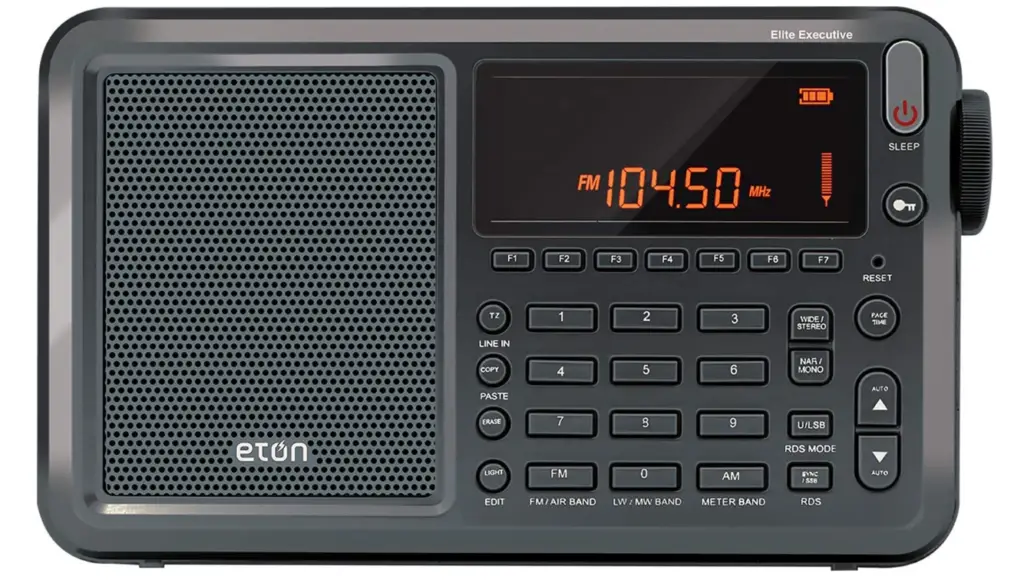
Elite Executive is a top-notch portable radio. It is slightly smaller than the Tecsun PL880/680 and is easy to carry, but still has all the features for excellent SWL reception and SSB results. This radio compares to Tecsun PL880, PL680, H501, and Sangean 909X in performance and is equally sensitive to picking up frequencies.
MW (AM) and FM offer good sensitivity and response. Rechargeable battery life (4 x AA) is excellent and rechargeable (Ni-MH) batteries can be charged in the radio using the included power adapter. What makes Elite Executive unique is its performance compared to other radios.
Users must spend some time with the manual to appreciate the many functions/features of this unique portable radio. The Elite Executive radio is largely designed for users.
That said, there are plenty of options to tailor the signal to your expectations using adjustable bandwidth, USB, LSB, sync, DX, local, external antenna, line in/out, etc. There are 700 memories (100 pages x 7 dots). to the side). Each page can be edited to have its own header name.
The holdall is protective and attractive, but users will likely prefer to use the portable radio without it as the Elite Executive has an integrated stand on the back and is easier to handle. It is recommended that you download the PDF manual from the Eton Canada website and read it on your computer while operating the radio to discover its many unique features and functions.
5. Eton Sidekick Weather Alert Emergency Radio
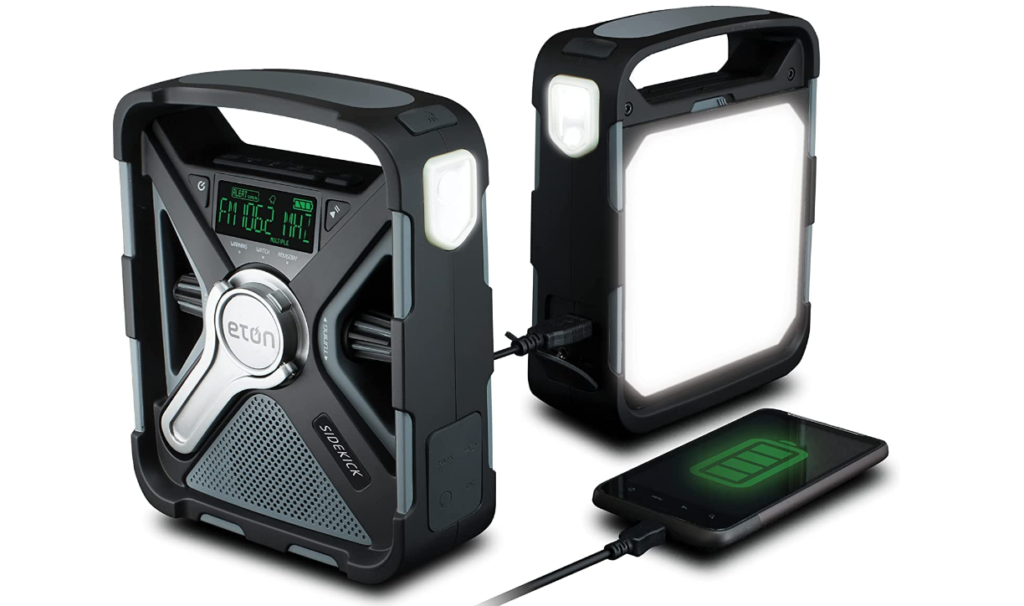
This is a very handy full-featured camping or emergency radio. The device has many interesting features such as Bluetooth, and SAME, alarm technology, weather channels, as well as a manual charger, a solar panel charger, and a USB port for charging the mobile phone.
Not to mention 3 headlights, AM and FM radio with memory channels. Some of these features were not known to me when I bought the best portable radio.
The first thing I tried was Bluetooth. It connected to my iPhone instantly and play/pause worked flawlessly. Another interesting feature in BT mode was the tuning knob. He played your songs. The speaker was surprisingly strong.
Ambient light is a cool feature. Lighted up my table surprisingly well. The red and white lights worked just as well as my cell phone. This a great way to conserve your cell phone battery while camping.
It was very easy for me to set up the weather band. Press the WB button and scroll through the channels. I found my local WB show in seconds. There was no severe weather at the time of review, so I didn’t test WB Alert, but the concept is cool.
I did some experiments with my phone battery charging at 18% and a fully charged Sidekick. In 15 minutes my phone charge increased by 6%. This seemed to be consistent every 15 minutes as Sidekick added 24% to my battery after an hour.
I haven’t made any attempts to charge the internal battery with the crank or solar panel, but the manual says the solar panel fully charges the internal battery in 14-16 hours.
Another interesting feature is the SAME emergency alert technology. The device allows you to preset up to 25 different districts around you or possibly different areas that may be of interest to you.
The radio notifies you when you are in the districts you have selected. I wasn’t aware of this broadcasting service until I bought this emergency radio. I went to Wikipedia for a full explanation of the broadcast technology and system.
6. Midland ER300 Emergency Radio

Midland is a premium brand when it comes to solar devices and for example, they offer several reliable solar devices. The Midland ER300 emergency radio guarantees efficient installation and allocation.
It packs a 2200mAh rechargeable battery and offers 32 hours of runtime on a full charge. Coming with a 1-year warranty, this solar radio is a multifunctional device. It also doubles as a power bank, SOS alarm, and flashlight, as well as a solar-powered radio.
Functions
- Multiple loading methods
The Midland ER300 emergency radio can be charged from multiple sources – solar panels, batteries, or dynamo.
- Bright LCD display
The Midland ER300 emergency radio has a bright LCD display that allows you to view and set functions. You can also see the time displayed by the digital clock and the battery level.
- Powerful external AA battery
This solar portable radio also doubles as a powerful charger for your digital devices – cell phone, etc. This item comes with a USB cable and an outlet that allows you to charge any portable digital device.
- Multifunctional
The Midland ER300 emergency radio is a multifunctional device, not just a solar radio. It is equipped with various functions such as a Cree 130L LED flashlight, ultrasonic dog call, and Morse code SOS.
This device is also equipped with an FM/AM receiver specially designed for emergencies. It is also a great companion for all your regular activities and outdoor activities.
7. Kaito Emergency Radio Voyager Max KA900
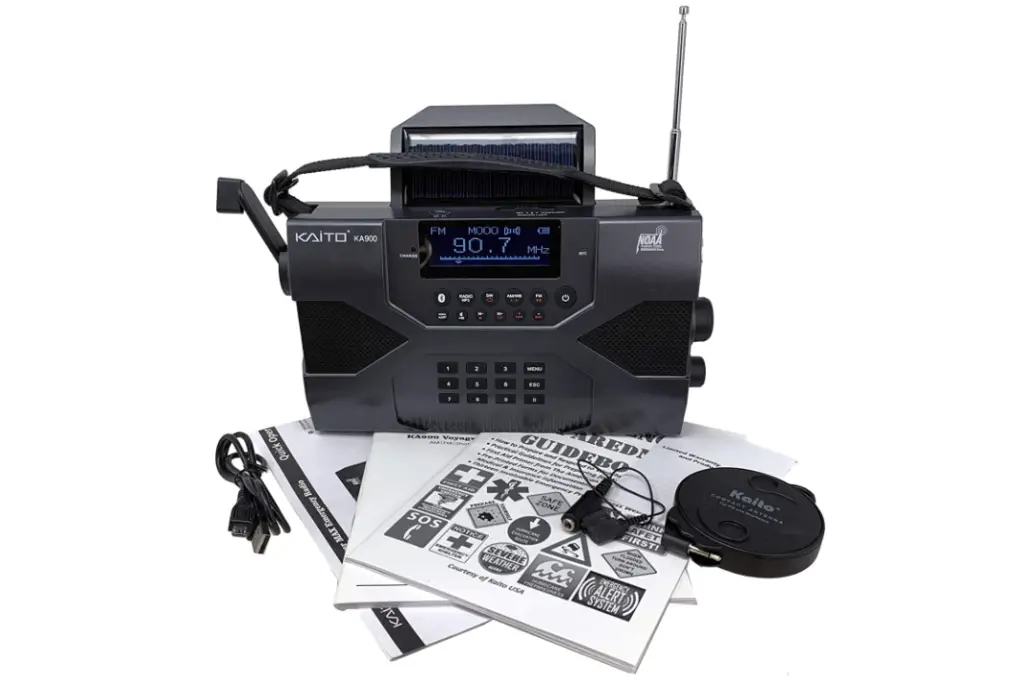
Introducing the newest and most advanced member of the Kaito Voyager family, the KA900 Voyager Max, a handheld digital receiver designed for both everyday use and emergency preparedness applications.
As a means of emergency preparedness, it offers a variety of power-up methods including an AC/DC adapter (NOT included), a built-in 2000mAh rechargeable lithium battery that can be charged with an optional AC adapter, manual start or USB power adapter, and the patented 180-degree foldable solar panel keeps the best portable radio powered even when no rechargeable battery is installed.
With its revolutionary design and versatile functions, it is not only an ideal bedside radio but also an indispensable tool for emergency preparedness, travel, camping, hiking, and other outdoor activities.
The KA900 has a wide range of reception including AM, FM, shortwave, and NOAA weather stations. 7 weather channels are pre-programmed and numbered from 1 to 7, you can easily and conveniently tune to stations by rotating the station search, no more guessing. When the radio is set to alarm mode, it will automatically wake up when it receives alarms from NOAA weather channels.
Combining two 1.5-inch speakers and all-digital circuitry, the KA900 delivers an uncompromising sound degree and an enhanced listening experience with excellent clarity and minimal distortion. Voyager Max is equipped with the latest Bluetooth technology that allows you to wirelessly stream audio/music from a Bluetooth-enabled device such as a smartphone.
To take full advantage of the KA900’s onboard MP3 player and digital audio equalizer, you can also connect an audio device directly to the 3.5mm input jack or insert a micro SD card up to 32GB.
What you should pay attention to when buying a camping radio
When searching for the best camping radio for your next big outdoor adventure, you may find that finding the right radio that fits your criteria can be quite difficult. This is especially true when you consider that there are hundreds or thousands of makes and models out there.
To make things a little easier for you, here are some features to look for when buying camper radios.
Power Sources
You need the best portable radio that can handle a variety of power sources. Camping radios should not be big and loud. Outer Space is quiet enough that even a small transistor radio will do, and these devices require very little power to operate.
That’s why you’ll find camping radios that run on one or two-button batteries, small solar panels and alternators, and battery charging systems. Some of them are also spring-loaded and use clockwork to turn them on.
Camping radio batteries can last a long time. Worst case scenario, however, your device will need to be powered by free, renewable energy so you can technically use it for as long as you want. This is very useful in the next power outage.
Weatherproof
Portable radios must withstand rain, falling in puddles, and accidental exposure to water or other liquids. If you make the wrong choice here, chances are your Noaa weather radio will break on your first-day camping.
Choose a radio station with at least an IPx4 rating. That means it can withstand water splashes from all directions. It can even be submerged underwater for a few seconds. Also, look for a Noaa weather radio that can withstand both low and high temperatures.
Sound quality
Just because an FM portable radio has to be robust and durable, doesn’t mean it has to sound bad. Internal speakers should provide acceptable sound quality. This means that music from FM stations should at least be beautiful.
The voice of the people in the chat should also be clear. Even if such a radio is intended for outdoor use, it should look good. It shouldn’t make noises that sound like they’re being played through a tin can.
Reception Quality
If you find that you have to hang it halfway up a tree or hook up an exterior antenna to get a clean AM radio signal, you know you’ve got the wrong radio. You don’t have to worry about receiving an FM station when you’re out in the woods.
This is because they were usually scattered by trees and other obstacles. All you have to do is extend the antenna and then adjust it so that the reception is as clear as possible.
Since there’s no accurate way to tell how well a particular weather radio is receiving, you’ll have to do some digging. Read as many customer reviews as you can to find out which ones are worth your money.
Lightweight and portable
If you’re going on a hike that involves walking to your campsite, you should carry a lightweight. Because every gram counts when hiking, choose a radio that isn’t too heavy without compromising on build quality and performance.
It should also be light enough to feel like you’re holding a child’s toy. It should feel solid and have some weight.
Shock Resistance
When you use anything outdoors, it’s inevitable that your gear will be subjected to numerous bumps and falls. The radio you should buy should be one that can take more than a drop or two.
Get one that looks like it could take punishment. A good example is the thick ABS body and hard rubber bumpers.
Strength
Multiple power sources for your radio ensure that you are never short of power to power it. Most of the time, power comes from batteries, but many radios these days also come with power panels and built-in rechargeable batteries.
Battery life
How long will you camp and how many hours will you listen to the radio? Depending on this, you can opt for longer battery life when using the radio for entertainment purposes. Choose one that lasts at least 20 hours before needing a charge.
Durability
Camping is a harsh environment that is not suitable for fragile equipment. Choose a radio that is sturdy, durable, and can withstand some rough handling.
IP rating
The IP rating indicates the radio’s resistance to harsh substances such as dust. It also indicates that the device is waterproof. Check your requirements and see if the rating matches them.
Other properties
If there is one feature that all camper radios should have, it should be the Noaa weather logo or a public warning. This means that the radio can receive weather forecasts or warnings. It has a dedicated transmit channel for the radio to tune into.
On the other hand, the presence of the Public Alert logo means the radio has an alarm and the horns are on. Facilities such as emergency lighting for the hearing impaired are also provided.
Also, read the article – The Best Camping Radios (Portable, Lightweight & Water-Resistant)

Different types of radio
Many types of radios have been developed over the past few decades and have evolved into many different forms, each with a different function. Despite the widespread use of radios, some people still know little about them. Read on to understand how each type of radio works.
AM radio
AM, or amplitude modulation, is one of the oldest forms of wireless broadcasting. Specifically, an audio signal changes the strength of the radio waves, which is called modulation. AM radio then decodes the modulation into an audible sound that the human ear can pick up. However, the sound degree is not always great because electrical noise can be received.
FM radio
Since their introduction in the 1930s, FM or frequency modulation radios have seen many advances. Unlike AM, FM radio focuses more on modulation and depends on signal strength. As a result, FM provides an improved sound degree with less electrical noise.
Short wave radio
Shortwave radio frequencies are between 1.7 and 30 MHz and interact with the ionosphere. Radio transmission can travel hundreds or thousands of kilometers, and people can tune in from anywhere on Earth. Shortwave radio users include government and commercial broadcasters.
Satellite Radio
This is a new form of commercial radio broadcasting. Its energy is supplied by satellites and it can cover large areas without reducing the sound degree. Not everyone can listen to satellite radio because it is equipped with a computer chip that blocks the receiver from accessing the channels. This requires a specific recipient and subscription.
Ham radio
Radio amateurs, also known as radio amateurs, operate on a unique set of frequencies approved by the Federal Communications Commission. It can carry signals for hundreds of miles like shortwave radio and is useful during natural disasters when local communications fail. But amateur radio use requires a license, training, and special equipment.
Other important factors to consider
What is Radio Camp?
Portable Radio is a compact radio transmitter that performs the basic audio functions of the previous version of this unit. The only difference is that they have some additional features such as the use of alternatives as a source of energy. In addition to normal AC cords and batteries, these radios can also run on solar power.
It can also be powered by a dynamo that needs to run to charge the internal battery. Camping radios also have additional features not found in traditional radios. As mentioned, you usually have access to Noaa weather channels and National Weather Service broadcasts.
Some even have useful features like flashlights and emergency beacons. Some also have USB ports that can be used to charge electronic devices. The latter feature is relatively new and could be a lifesaver these days, especially since most people can’t live without their smartphones.
Who is Camp Radio for?
Just because it’s a radio for camping doesn’t mean it’s just for camping. Of course, the people most likely to use these radios are people who go camping regularly. This is because they typically have excellent reception and can pick up communications even deep in dense forests.
First responders can also benefit from having these devices in their vehicles. Receiving reports that severe weather is coming and this is confirmed by walkie-talkies, they begin to go on high alert, ready to help anyone affected.
Survivors will also want to keep one or two of these devices in their go bag or emergency stash. During the SHTF period, power lines are very likely to be out of service in the city. Camping radio transmissions are the only way to receive information.
In the worst case, camping radios are the only devices that can receive radio transmissions. Even if you’re not prepared for the destruction of society as we know it, it’s always a good idea to keep a portable radio in the glove compartment of your car – you never know when you might get lost on an unfamiliar road.
You also can’t expect the road leading to your house to be washed out by a freak landslide, or another driver to block the road and be stranded in your car.
In these cases, instead of wasting precious fuel in your tank, turn on your radio for camping and stay up to date on what’s going on around you. It doesn’t matter if you like hiking or not. Having at least one of these in your home and car is extremely beneficial.
How does Field Radio work?
Field radios are still technically transistor radios. The only difference is that there are some configurations that also allow it to be used in emergencies. The main difference between traditional radios and camping radios is that the latter does not require AC power and does not require batteries.
You can enable them in another way. A radio for camping is also a multifunctional tool. Many of them are used not only to receive radio broadcasts.
The most popular addition is the built-in flashlight. This means always having a flashlight ready in case something unforeseen happens.
The most popular addition is the built-in flashlight. This means always having a flashlight ready in case something unforeseen happens.
It can also be used when you need to quickly scout what is near your camp. Perhaps the most popular and perhaps the most important addition to camping radios is the USB socket that can be used to charge your electronic devices.
These include smartphones, GPS devices, and other devices. As long as the radio has enough charge, it will share the charge with other devices that need it.
What types of camping radios are there?
The main way to easily identify a camping radio is by how it is powered. As mentioned above, these radios receive power from various sources.
First, it is what is called a traditional transistor radio. It’s very simple because it’s just an AM/FM tuner and nothing else. The best thing about these radios is that they consume very little power. This can extend the life of the battery by about a week before you need to replace it.
Some small camping radios have a built-in solar panel to charge small internal AA batteries. A few hours of exposure to solar power is enough to charge the AA batteries fully. This can create hours of radio content.
Some emergency radios have a built-in dynamo connected to a small battery pack. Starting the dynamo charges the internal battery. The more you turn it, the faster the battery will charge. You can also find clock radios that work in a similar way. Instead of manual activation, however, a wound helical spring is used to turn the dynamo. This will turn on the radio directly.
Why do you need a camping radio?
Investing in a camping radio is necessary for many reasons. It’s more than just luxury, as this unit performs several important functions. First, a camping radio gives you instant access to an emergency broadcast system.
For example, if there are a lot of dark clouds on the horizon, you may get a message from NOAA warning people who live nearby to evacuate the area. This allows us to act in the right way at the right time.
For example, if there are a lot of dark clouds on the horizon, you may get a message from NOAA warning people who live nearby to evacuate the area. This allows us to act in the right way at the right time.
Even if you’re not camping, if a storm hits your town and you lose power, you’ll probably need a radio to hear the news around you. Plus, many radios can be charged via micro USB cable, so you don’t have to worry about running out of battery on your smartphone.

Advantages and disadvantages of camping radios
Streaming may be on the rise, but radio is still widely used by many. With Camping Radio you can listen to various AM and/or FM radio stations with valuable news and entertaining music. Additionally, most camper radios these days have features that make outdoor adventures more enjoyable. If you plan to buy one of them, this list of pros and cons can help you decide.
Benefits
- Light and comfortable to take anywhere
- There are additional features such as a flashlight and an external battery.
- No boring time with affordable music for entertainment
- Always stay up to date with the latest news
- Useful in emergencies
- It can increase your chances of survival during a natural disaster
Defects
- It takes time to get used to it
- More expensive due to advanced technological features
There is no doubt that everyone can benefit from the best camping radio. It is especially important to take it with you on any outdoor tour. If you still have doubts, please think again. Radio camping has more advantages than disadvantages.
Top 10 factors to buy the best portable camping radio
- Battery life. The best portable radios for camping should have a long battery life and solar panel so that they can be used for a long time on a single charge.
- Solar Power. Solar energy is a great way to keep your radio running even without sunlight.
- Holding hands. A hand crank is a great way to generate electricity without sunlight.
- LED Flashlight. You can use the LED flashlight to navigate in the dark. It is also important that the LED flashlight is bright enough to be used as emergency lighting in an emergency.
- NOAA Weather Alerts. The NOAA Weather feature is a great way to keep up to date with the latest weather conditions in your area.
- Rechargeable lithium-ion battery. The rechargeable lithium-ion battery is a great way to keep your radio running for hours without worrying about running out of charge.
- FM Radio: FM radio is a great way to keep yourself entertained while camping. Many consider this feature very important, absolutely necessary, and should not be neglected.
- AM/FM switch. The AM/FM switch is a great way to switch between AM and FM radio stations.
- Headphone jack. The headphone jack is a great way to listen to the radio without disturbing others.
- Carry a bag. A carry case is a great way to keep your radio safe when camping. The tote bag should be durable and waterproof.
FAQ Radio for camping
What is the best portable radio on the market?
With so many different makes and models of camping radios out there, picking just a few and recognizing them as reliable can seem like an impossible task. However, after all the reviews I’ve seen, many manufacturers are very proud of their products.
When it comes to camping radios, you can never go wrong with trusted brands and suppliers like C. Crane CCRadio 3 Long Range Reception, C. Crane CCRadio 3, and Eton – Elite 750.
Which is best pocket FM radio?
C. Crane CCradio 2E Enhanced is an excellent radio. Attracts remote AM stations better than any radio you’ve ever seen. It really opened up the AM band for me and I enjoy listening to different FM stations states at night. FM reception is also excellent.
Which brand is best for FM radio?
The best brands for FM radio are C. Crane radio 2E Enhanced, C. Crane CCRadio 3, Eton – Elite 750, and Kaito Emergency Radio.
What is the best battery-operated radio?
The best battery-operated radio is Eton – Elite Executive and Midland ER300 Emergency.
Conclusion
The best radio for camping is a must-have for your camping gear, which can sometimes save lives. These investments are critical to providing the required functionality and value. We hope that our product reviews and buying guides will help you find the best travel radio. If you have already found the best camping radio for you, please share your experiences with us!
You may be interested in – How to block radio waves in your house: tips and lifehacks
